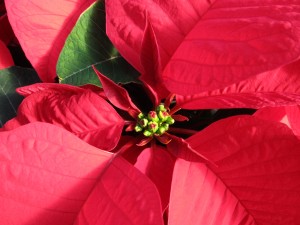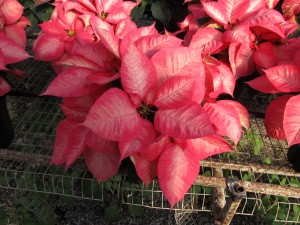The beautiful poinsettia (Euphorbia pulcherrima) has become a symbol of the Christmas and winter holidays. The showy colorful bracts, that most people think are the flowers, are actually modified leaves. The tiny “true” flowers are in the center of the bracts.
Joel R. Poinsett introduced the poinsettia plant to the United States from Mexico. Poinsett was a botanist, physician and the first U.S. Ambassador to Mexico. In Mexico poinsettia grows as a 10-15 feet tall perennial shrub. In the U.S. plants thrive in Florida and Southern California gardens (zone 9). Here, they’re sometimes planted in late summer where the vivid bract colors add pizzazz to the fall-winter landscape. Plants hold up to night temperatures in the upper 30’s.
A member of the botanical family Euphorbiaceae, leaves and stems ooze milky sap. However, no parts of a poinsettia plant are poisonous. Some people and pets may develop a skin irritation from the sap.
Tips on purchasing: before purchasing the true flowers should be fully formed and tightly closed. If the yellow pollen sacs have shed or the flowers have dried out, do not purchase. Once the flowers start to age, the colorful bracts soon decline. The plant may look poorly on Christmas Day.
Care In The Home: place your poinsettia near a sunny window that faces south or east and room temperatures are between 65 to 75 °F. Poinsettias thrive in a well-drained soilless media (potting mix). Check for dry soil every few days and water thoroughly; excess water should flow freely out the drainage hole in the container. Never leave a poinsettia standing in water for over one-half day as it may cause root injury. Feed the plant every 2-3 weeks with a water soluble fertilizer @ one-half the rate of package directions through the winter months. Your poinsettia may still look beautiful on the first day of spring.
There are more than 100 varieties of poinsettias available today. Varieties come in lots of colors from traditional red, white, pink, burgundy, marbled and speckled.



 Posted in
Posted in 
